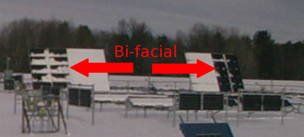J.M.Pearce (talk | contribs) m (→Source) |
J.M.Pearce (talk | contribs) m (→Source) |
||
| Line 3: | Line 3: | ||
==Source== | ==Source== | ||
* Laurie Burnham, Daniel Riley, Bevan Walker and Joshua M. Pearce. Performance of Bifacial Photovoltaic Modules on a Dual-Axis Tracker in a High-Latitude, High-Albedo Environment | * Laurie Burnham, Daniel Riley, Bevan Walker and Joshua M. Pearce. Performance of Bifacial Photovoltaic Modules on a Dual-Axis Tracker in a High-Latitude, High-Albedo Environment, ''2019 IEEE 46th Photovoltaic Specialists Conference (PVSC)'', Chicago, IL, USA, 2019, pp. 1320-1327. [https://www.academia.edu/41838185/Performance_of_Bifacial_Photovoltaic_Modules_on_a_Dual-Axis_Tracker_in_a_High-Latitude_High-Albedo_Environment open access] | ||
** [https://energy.sandia.gov/programs/renewable-energy/solar-energy/photovoltaics/pv-systems-and-reliability/snow-as-a-factor-in-photovoltaic-performance-and-reliability/ Sandia - The Impact of Snow on PV Performance] | ** [https://energy.sandia.gov/programs/renewable-energy/solar-energy/photovoltaics/pv-systems-and-reliability/snow-as-a-factor-in-photovoltaic-performance-and-reliability/ Sandia - The Impact of Snow on PV Performance] | ||
Revision as of 00:43, 15 February 2020
Source
- Laurie Burnham, Daniel Riley, Bevan Walker and Joshua M. Pearce. Performance of Bifacial Photovoltaic Modules on a Dual-Axis Tracker in a High-Latitude, High-Albedo Environment, 2019 IEEE 46th Photovoltaic Specialists Conference (PVSC), Chicago, IL, USA, 2019, pp. 1320-1327. open access
Abstract

Bifacial photovoltaic dual-axis tracker systems have the potential to out-perform other module/mounting configurations at high latitudes, where the reflectivity of snow in winter boosts bifacial performance and the low solar angle-of-incidence favors dual-axis tracking. Two years of empirical data from dual-axis experimental systems in Vermont support this assertion, demonstrating that bifacial modules on a dual-axis tracker produced 14 percent more electricity in a year than their monofacial counterparts and as much as 40 percent during the peak winter months. These bifacial gains are in addition to the estimated 35-40 percent energy gains of a dual-axis tracker relative to a fixed-tilt system. Such findings suggest that bifacial two-axis tracker systems could be economically attractive in northern latitudes, with high-efficiency modules compensating for the trackers' installation and maintenance costs, and future design improvements enabling further performance gains.
See Also
- Details on PV performance monitoring by R. Andrews. PV Performance Modeling: Assessing Variability, Uncertainty and Sensitivity. Solar Professional Issue 8.5, Sep/Oct 2015.
- "The 10 Snowiest Places on the Planet" by the Mother Nature Network.
Related Pages
- Differences in Snow Shedding in Photovoltaic Systems with Framed and Frameless Modules
- Impact of Snow and Ground Interference on Photovoltaic Electric System Performance
- Effects of snow on photovoltaic performance
- Open Solar Outdoors Test Field
- Outdoor data acquisition
- Queen's Innovation Park Test Site
- Solar resource measurement for PV applications
- Prediction of energy effects on photovoltaic systems due to snowfall events
- A new method to determine the effects of hydrodynamic surface coatings on the snow shedding effectiveness of solar photovoltaic modules





